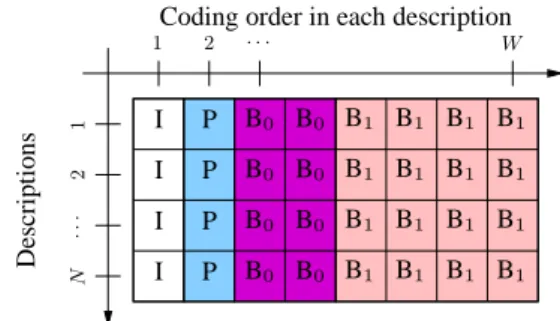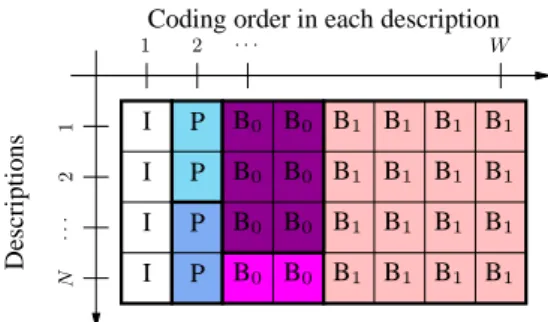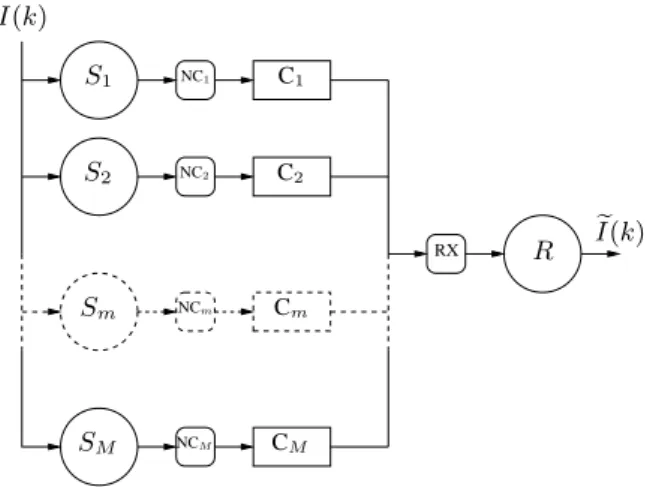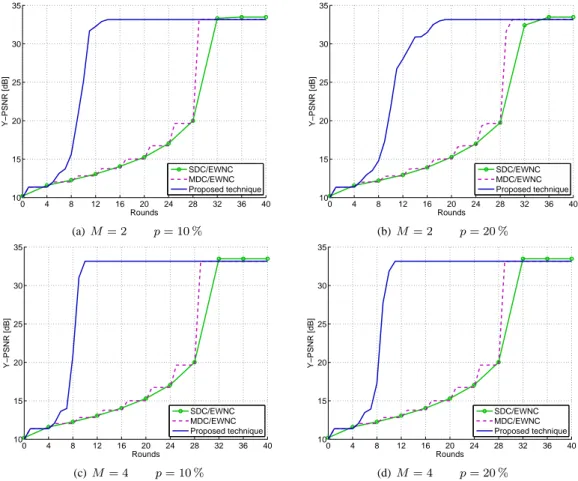HAL Id: hal-00781305
https://hal-imt.archives-ouvertes.fr/hal-00781305
Submitted on 19 Mar 2013
HAL is a multi-disciplinary open access
archive for the deposit and dissemination of
sci-entific research documents, whether they are
pub-lished or not. The documents may come from
teaching and research institutions in France or
abroad, or from public or private research centers.
L’archive ouverte pluridisciplinaire HAL, est
destinée au dépôt et à la diffusion de documents
scientifiques de niveau recherche, publiés ou non,
émanant des établissements d’enseignement et de
recherche français ou étrangers, des laboratoires
publics ou privés.
A network coding scheduling for Multiple Description
video streaming over wireless networks
Claudio Greco, Irina Delia Nemoianu, Marco Cagnazzo, Beatrice
Pesquet-Popescu
To cite this version:
Claudio Greco, Irina Delia Nemoianu, Marco Cagnazzo, Beatrice Pesquet-Popescu. A network
cod-ing schedulcod-ing for Multiple Description video streamcod-ing over wireless networks. European Signal
Processing Conference (EUSIPCO), Aug 2012, Bucarest, Romania. pp.1915-1919. �hal-00781305�
A NETWORK CODING SCHEDULING FOR MULTIPLE DESCRIPTION VIDEO
STREAMING OVER WIRELESS NETWORKS
Claudio Greco, Irina Delia Nemoianu, Marco Cagnazzo, B´eatrice Pesquet-Popescu
TELECOM-ParisTech, TSI department, 46 rue Barrault, 75634 Paris Cedex 13, FRANCE
{greco,nemoianu,cagnazzo,pesquet}@telecom-paristech.fr
ABSTRACT
Network coding (NC) can achieve the maximum information flow in a network by allowing nodes to combine received packets before retransmission. Several works have shown NC to be beneficial in wireless networks, but the delay in-troduced by buffering before decoding raises a problem in real-time streaming applications. Here, we propose a frame-work for video delivery in wireless netframe-works that combines Expanding Window Network Coding (EWNC), Multiple De-scription Coding (MDC), and a novel Rate-Distortion Opti-mised (RDO) scheduling algorithm that optimises the order in which the video packets are included in the coding window at the current sending opportunity. Results show that our ap-proach consistently outperforms both EWNC applied on sin-gle description coding (SDC) and EWNC applied to MDC when a trivial scheduling is used.
Index Terms— Network coding, multiple descriptions,
video coding, wireless networks.
1. INTRODUCTION
Network Coding (NC) [1] has recently been investigated by
the research community as an alternative to classical routing for multicast streaming. Using NC, a multi-hop communi-cation is relayed at intermediate nodes by sending combina-tions of the received messages, rather than mere copies. An interesting application of NC is to grant partial loss immu-nity to data streams in unreliable wireless networks [2]. Us-ing Random Linear Network CodUs-ing (RLNC) [3], a technique in which nodes send combination vectors, i.e., random lin-ear combinations of their received packets, with coefficients taken from a finite field of proper size, the communication can be routed in unreliable networks with dynamically vary-ing connections with no need for node coordination.
A practical implementation of RLNC [4] (PNC) can be achieved segmenting the data into groups of packets called
generations and combining only packets belonging to the
same generation. All packets in a generation are jointly de-coded as soon as enough linearly independent combinations have been received, by means of simple linear system solv-ing. Since the coefficients are taken from a finite field, perfect
reconstruction is assured regardless of the precision of the implementation.
Recently [5], it has also been proposed to apply NC to video content delivery, dividing the video stream into layers of priority and providing unequal error protection for the dif-ferent layers via PNC. Layered coding requires that all users receive at least the base layer, hence all received packets must be stored in a buffer until a sufficient number of independent combinations are received, which introduces a decoding delay that is often unacceptable in real-time streaming applications. There exist several techniques aimed to reduce the decoding delay, proposed by both the NC and the video coding com-munities.
From a network coding perspective, a viable solution is to use Expanding Window Network Coding (EWNC) [6]. The key idea of EWNC is to increase the size of the coding
win-dow (i.e., the set of packets in the generation that may appear
in combination vectors) for each new packet. Using Gaussian elimination at the receiver side, this method provides instant
decodability of packets. Thanks to this property EWNC is
preferable over PNC in streaming applications. Even though PNC could achieve almost instant decodability using a small generation size, this would be ineffective in a wireless net-work, where a receiver could be surrounded by a large num-ber of senders, and if the size of the generation is smaller than the number of senders, some combinations will necessarily be linearly dependent. On the other hand, EWNC automatically adapts the coding window size allowing early decodability, and innovativity (i.e., linear independence) can be achieved if the senders include the packets in the coding window in a dif-ferent order. However, these orders should take into account the RD properties of the video stream, as we shall discuss in detail in Sec. 2.
Another possibility is to employ NC jointly with
multi-ple description coding (MDC). MDC [7] is a well established
joint source-channel coding paradigm based on splitting a me-dia content into N sub-streams, referred to as descriptions. Any description can be independently decoded for represent-ing the content, but the quality improves with the number of descriptions. Video MDC has been proven to be a valuable tool to cope with packet losses in wireless networks [8].
In this work, we propose to jointly use EWNC and video MDC, in order to provide a robust video delivery over an un-reliable wireless network, without any need for centralised control or feedback channel. In order to do so, we design a
Rate-Distortion Optimised (RDO) scheduling algorithm that,
at each sending opportunity, selects which video packet has to be added to the coding window in such a way as to maximise the expected video quality perceived by the receiver. Since the wireless medium is inherently broadcast, we want to ex-ploit the possibility of the receiver being exposed to multiple senders. In other words, we assure that the senders transmit innovative coding vectors even though they do not coordinate their actions.
2. PROPOSED APPROACH
In this section, we detail our proposed framework, whose ob-jective is to provide a novel transmission strategy for lossy wireless networks able to guarantee a good trade-off between resiliency to losses and timely delivery.
In our scenario, a set of M uncoordinated sources transmit the same encoded video sequence to a single receiver. This scenario could model, for instance, a single hop of a multi-hop transmission.
We propose to jointly use EWNC and video MDC, which we expect to provide loss resiliency to the video stream with-out affecting the delay. However, as mentioned in Sec. 1, the efficiency of EWNC highly depends on the order in which the packets are included in the coding window. The original EWNC method was proposed for layered video coding, there-fore the priority of the packets was naturally imposed by the dependencies among layers. Such a strategy is unfeasible in our scenario, as we deal with multiple uncoordinated senders sharing a broadcast medium, and if they all were to choose the same order of packets (i.e., the one imposed by the layered structure), at any given sending opportunity they would send
non-innovative combinations. In general, if a prioritisation is
optimal, it is also unique, and thus all the senders would al-ways transmit dependent combinations, defeating the purpose of using NC. However, there exist frames with very similar RD-properties, hence we can generate a variety of scheduling slightly suboptimal, but with performances very close to the optimum.
For instance, the GOP structure of a video coding tech-nique (such as H.264/AVC) leaves a certain degree of free-dom in the scheduling, as frames on the same prediction level can be sent in any order (two examples of GOP structures are shown in Fig. 1), but this may not be enough to provide a suf-ficient number of different schedules for the different senders. Using an MDC technique, it is possible to have multiple senders transmitting packets that refer to the same instant, but different nonetheless. Furthermore, corresponding packets of different descriptions are mutually refinable, therefore a node being served by multiple senders will perceive an enhanced
I I B1 B0 B1 P B1 B0 B1
W (a) Hierarchical-B GOP (W = 8, 4 prediction levels)
I P
P B0 B0 P B0 B0
B0
W (b) Tree GOP (W = 7, 3 prediction levels)
Fig. 1. Two possible GOP structures in H.264/AVC. Arrows indi-cate prediction. Frames on the same prediction level can be sent in any order.
video quality. Using MDC, the pool of frames candidate for inclusion in the coding window is a bi-dimensional multiple
description GOP (MD-GOP), i.e., a rectangular buffer of size
N× W , where N is the number of descriptions and W is the
GOP size of each description. An example of MD-GOP is depicted in Fig. 2, for4 descriptions and a GOP structure of
each description as the one in Fig. 1(a), i.e., Hierarchical-B. Notice that in the buffer the frames are not ordered by their play-out date, but in the encoding order, so that frame depen-dencies are respected.
I I I I P P P P B0 B0 B0 B0 B0 B0 B0 B0 B1 B1 B1 B1 B1 B1 B1 B1 B1 B1 B1 B1 B1 B1 B1 B1 D es cr ip ti o n s
Coding order in each description
1 2 1 2 ·· · · · · N W
Fig. 2. MD-GOP for N = 4 descriptions and W = 8 frames in
Hierarchical B-frame GOP. Frames are ordered by prediction level.
The task of the scheduler is to provide an order in which the frames in the MD-GOP are included in the coding win-dow. Since wireless networks are affected by churn and bility and the video stream can be interrupted at any mo-ment, it is desirable that any new combination maximise the marginal benefit in terms of RD properties. In other words, at each step, we want the scheduling algorithm to select the frame that optimises an RD criterion for insertion in the cod-ing window. However, the correspondcod-ing frames of different descriptions might have differences in their RD properties, which would still lead to a unique optimal policy of inclusion in the coding window.
In order to obviate this problem, we propose a clustering of the video frames. The clustering is a classification of the frames that takes place at video source, after the video en-coding and before scheduling for transmission. Its purpose is to improve diversity by letting nodes transmitting, at each sending opportunity, a random frame within an optimal clus-ter. Clusters are decided once at the encoder, where rate and distortion are known with negligible computational overhead, with frames in the same prediction level. The average rate and distortion of the cluster R(c) and D(c) are then computed,
possibly quantised, and added as a header to each frame in the cluster.
At each sending opportunity, among the clusters whose prediction level is compatible with the scheduling so far (C),
each sender chooses the cluster c that minimises the cost func-tion J∗= min
c∈C{J(c) = R(c) + λD(c)}. Within this cluster,
each sender randomly chooses one frame and schedules it for transmission. This frame is added to the encoding window, increasing its size by one. The size of the coding window is reset to one with the new GOP.
An example of frame clustering is presented in Fig. 3. There, the I-frames of the 4 descriptions have roughly the
same RD properties and are therefore assigned to a single cluster. On the P-frames, on the other hand, descriptions1
and2 have similar RD properties between them, but
differ-ent from descriptions3 and 4, which are in turn close to each
other. In this case, two clusters are created containing the frames with similar properties. The same holds true for the B0-frames, where descriptions1, 2 and 3 have been clustered
together, while description4 was assigned to another cluster.
Finally, all B1frames of all descriptions give similar
contribu-tions to distortion and have been assigned to a single cluster. Large clusters increase the diversity of the scheduling among senders, thus reducing non-innovative packets. How-ever, if clusters are chosen too large, the scheduler will ran-domly choose among frames with very different values of the objective function, resulting in a sub-optimal performance. Ideally, the size of the clusters should be chosen according with the expected number of senders that are going to trans-mit at the same time, which can be roughly estimated with the node density of the network. In practice, clustering can be performed in several ways. For instance, a coarse but simple scheme is to assign all the frames on the same pre-diction level to a single cluster. This scheme is independent from the actual RD properties of the sequence and can be easily implemented; nevertheless, it can be quite efficient if the descriptions are actually frame-by-frame balanced. If the corresponding frames of different descriptions have slightly unbalanced properties, then a more sophisticated scheme can be employed, e.g., based on thresholding.
An example of two different scheduling orders compatible with the clustering of Fig. 3 is presented in Fig. 4. For the sake of clarity, only the scheduling for the first16 packets is
presented. We can observe that, if only a subset of a cluster
I I I I P P P P B0 B0 B0 B0 B0 B0 B0 B0 B1 B1 B1 B1 B1 B1 B1 B1 B1 B1 B1 B1 B1 B1 B1 B1 D es cr ip ti o n s
Coding order in each description
1 2 1 2 ·· · · · · N W
Fig. 3. Example of MD-GOP clustering. Frames marked by the same colour are in the same cluster and share similar RD properties.
1
1
2
2
3
3
4
4
5
5
6
6
7
7
8
8
9
9
10
10
11
11
12
12
13
13
14
14
15
15
16
16
Fig. 4. Two possible schedules (first16 packets). The numbers
indicate the order in which the frame is included in the coding win-dow. The dashed border identifies which frames have been selected for inclusion in the coding window at the16-th packet.
is chosen, the two schedulers choose different frames within it. If the whole cluster is chosen, then the frames still differ in the order they are included in the coding window.
3. EXPERIMENTAL RESULTS
In the following, we present the results of the proposed technique and compare them with the results achievable via EWNC applied to an SD-coded stream and EWNC applied on an MD-coded stream, but ordered using a trivial schedule. The transmission scenario we simulate is depicted in Fig. 5. In this scenario, M sources Sm, m = 1, . . . , M ,
intend to transmit the same video sequence, I(k), k = 1, . . . , K, to a single receiver R.
For SDC, the trivial strategy consists in including the frames in coding order, i.e., by prediction level and, within frames on the same level, play-out order. For MDC, we assume again that frames are included in coding order and, within frames with the same encoding time (i.e., correspond-ing frames of independently encoded descriptions), the de-scriptions are selected in a fixed order. To encode the video sequences, we chose to use4-descriptions Polyphase
Down-sampling Multiple Descriptions (PDMD) [9, 10], a technique
where N sub-streams are generated by splitting the origi-nal sequence via polyphase down-sampling along rows and columns by a factor of2. To generate the descriptions, each
sub-stream is independently encoded using an H.264/AVC reference encoder JM [11], version 17.0. The encoding algo-rithm uses the closed-GOP structure presented in Fig. 1(a). A closed-GOP was preferred in order to reduce error propaga-tion in case of losses. The RD properties of each frame are exactly measured. Clustering is performed based on
predic-tion level. The average rate and distorpredic-tion for the frames in each cluster are computed, quantised on eight bits each, and sent along with the video data.
At the decoder side, all the descriptions are independently decoded in order to obtain the N sub-streams, which the re-ceiver interleaves to reconstruct the central sequence. When some descriptions are lost, the receiver oversamples the avail-able sub-streams, interpolating the missing pixels to obtain a good low-resolution frame (side decoding). When none of the descriptions is available, the loss is concealed using the closest decoded frames.
In order to compare the performance of the method under a variety of inputs, we selected a set of10 QPs (in Tab. 1) and 8 video sequences (in Tab. 2) with CIF spatial resolution at 30
frames per second.
High Bitrate 16 19
Medium Bitrate 22 25 28 31
Low Bitrate 33 36 39 42
Table 1.QPs used in encoding the video sequences. akiyo hall foreman city coastguard football stefan bus Table 2.Video sequences used in simulations.
In order to allow a clear evaluation of our technique, a discrete-time transmission model is assumed: the time is seg-mented in transmission rounds wherein each source Smsends
exactly one packet from a predetermined transmission buffer TXm. Each channel Cm between transmission buffer TXm
and the receiver buffer RX is in general lossy, with indepen-dent uniform packet loss probability pm; the transmissions on
different channels do not interfere with each other. At the end of each round, the receiver decodes all the frames available in its buffer RX, generating a reconstructed sequence eI(k).
This simple scenario is well suited to model a wireless ad-hoc network where a channel reservation mechanism is en-forced [12], which provides both discrete-time transmission and channel isolation.
In our simulations, the proposed approach has proven to be able to deliver an acceptable video quality to the receiver in a shorter number of rounds than the reference techniques. As an example, in Fig. 6, we report a comparison with the reference techniques under a few different simulation condi-tions. We observe that, thanks to the variety in the scheduling, our technique is able to reduce the number of linearly depen-dent coding vectors, and is therefore able to provide a better video quality (in terms of Y-PSNR) in fewer rounds. It should be noted that the final value of the Y-PSNR for the SD-based technique is slightly higher (about0.5 dB) than that of both
MD-based ones, which is a direct consequence of the inher-ent redundancy among the descriptions of the MD encoding. However, this happens after a long enough time (i.e., about30
I(k) e I(k) S1 S2 Sm SM R NC1 NC2 NCm NCM RX C1 C2 Cm CM
Fig. 5.Simulated scenario. I(k) and eI(k) are respectively the
orig-inal and reconstructed frames, Sm, m= 1, . . . , M are the senders,
NCmthe network coding modules, Cmthe channels, RX is the
re-ceiver R’s buffer.
rounds), during which MDC/NC has already achieved its fi-nal Y-PSNR. We can also observe that the performance of the method benefits from a higher number of sources, whereas it is of course negatively affected by the loss rate.
4. CONCLUSIONS
In this work, we presented a novel technique for video stream-ing over unreliable channels usstream-ing a combination of multiple description coding and network coding.
The key idea in this technique is to use Expanding Win-dow Network Coding in order to guarantee instant decod-ability to the flow. The frames are included in the coding window in an order determined by an RD-optimised sched-uler. In order to reduce the probability of generating non-innovative packets, the sources operate a classification of the frames (clustering) that provides them with a degree of free-dom in the choice of the schedule.
We compared the performance of our technique with Ex-panding Window Network Coding applied on both on Single Description and Multiple Description coding, assuming a triv-ial scheduling order, and (in the case of MDC) limiting the combinations within the same description. We observe that the introduction of the scheduling, jointly with the possibility of mixing packets across descriptions, significantly improves the performance w.r.t. the reference techniques, in terms of video quality perceived by the user.
The result we obtained suggests that further research in this direction could be promising, in particular in the direc-tion of a joint design of an overlay management protocol that could select which nodes of the network should relay the stream.
0 4 8 12 16 20 24 28 32 36 40 10 15 20 25 30 35 Rounds Y−PSNR [dB] SDC/EWNC MDC/EWNC Proposed technique (a) M = 2 p = 10 % 0 4 8 12 16 20 24 28 32 36 40 10 15 20 25 30 35 Rounds Y−PSNR [dB] SDC/EWNC MDC/EWNC Proposed technique (b) M = 2 p = 20 % 0 4 8 12 16 20 24 28 32 36 40 10 15 20 25 30 35 Rounds Y−PSNR [dB] SDC/EWNC MDC/EWNC Proposed technique (c) M = 4 p = 10 % 0 4 8 12 16 20 24 28 32 36 40 10 15 20 25 30 35 Rounds Y−PSNR [dB] SDC/EWNC MDC/EWNC Proposed technique (d) M = 4 p = 20 %
Fig. 6.Comparison of the average Y-PSNR of the decoded sequences, for M sources and packet loss probability p.
References
[1] R. Ahlswede, Ning Cai, S.-Y.R. Li, and R.W. Yeung, “Network infor-mation flow,” IEEE Trans. Inf. Theory, vol. 46, no. 4, pp. 1204–1216, July 2000.
[2] Sachin Katti, Hariharan Rahul, Wenjun Hu, Dina Katabi, Muriel M´edard, and Jon Crowcroft, “XORs in the air: practical wireless net-work coding,” ACM SigComm Computer Commun. Rev., vol. 36, no. 4, pp. 243–254, Aug. 2006.
[3] T. Ho, M. Medard, R. Koetter, D.R. Karger, M. Effros, Jun Shi, and B. Leong, “A random linear network coding approach to multicast,”
IEEE Trans. Inf. Theory, vol. 52, no. 10, pp. 4413–4430, Oct. 2006.
[4] P.A. Chou, Y. Wu, and K. Jain, “Practical network coding,” in Proc. of
Allerton Conf. on Commun. Control and Comput., Monticello, IL, Oct.
2003.
[5] N. Thomos, J. Chakareski, and P. Frossard, “Prioritized distributed video delivery with randomized network coding,” IEEE Trans.
Multi-media, vol. 13, no. 4, pp. 776–787, Aug. 2011.
[6] D. Vukobratovi´c and and V. Stankovi´c, “Unequal error protection ran-dom linear coding for multimedia communications,” in Proc. of IEEE
Workshop on Multimedia Sign. Proc., Saint-Malo, France, Oct. 2010,
pp. 280–285.
[7] Vivek K. Goyal, “Multiple description coding: compression meets the network,” IEEE Signal Processing Mag., vol. 18, no. 5, pp. 74–93, Sept. 2001.
[8] Y. Wang, A.R. Reibman, and S. Lin, “Multiple description coding for video delivery,” Proc. IEEE, vol. 93, no. 1, pp. 57–70, Jan. 2005, In-vited Paper.
[9] N. Franchi, M. Fumagalli, R. Lancini, and S. Tubaro, “Multiple de-scription video coding for scalable and robust transmission over IP,”
IEEE Trans. Circuits Syst. Video Technol., vol. 15, no. 3, pp. 321–334,
Mar. 2005.
[10] M. Caramma, M. Fumagalli, and R.C. Lancini, “Polyphase down-sampling multiple-description coding for IP transmission,” in Proc.
of SPIE, 2000, vol. 4310, p. 545.
[11] Karsten S ¨uhring, “JM reference software release 17.0,” Source Code, Jan. 2011.
[12] Claudio Greco and Marco Cagnazzo, “A cross-layer protocol for co-operative content delivery over mobile ad-hoc networks,” Inderscience
Int. J. of Commun. Networks and Distrib. Syst., vol. 7, no. 1–2, pp.



